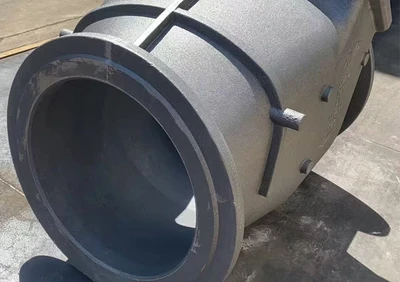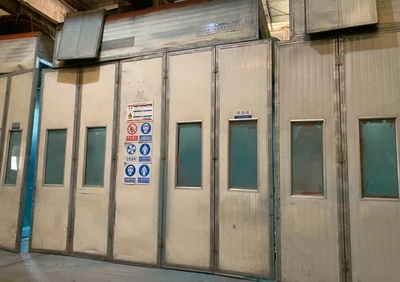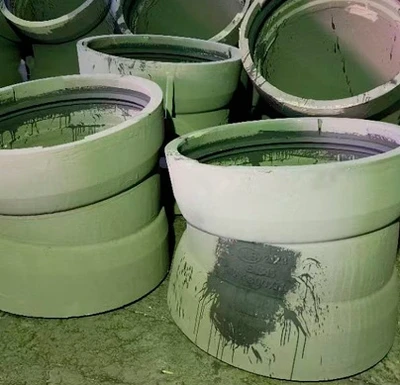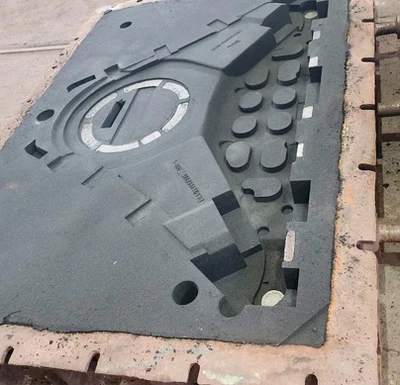Choosing the right casting method is crucial for producing high-quality metal components, especially for industries like agriculture. Resin sand casting and green sand casting are two widely used techniques, each with unique characteristics. This blog compares these methods, focusing on their suitability for agricultural machinery casting, and highlights why Balasen, a leading foundry in China, often opts for furan resin sand casting. By understanding their differences, manufacturers can select the best process for their needs, balancing cost, precision, and complexity.
Resin sand casting uses a mixture of silica sand and a chemical resin binder, such as furan or phenolic resin, to create strong, rigid molds. The resin, combined with a hardener, cures to form a durable mold capable of withstanding high pouring pressures. This method, employed by Balasen for carbon steel casting China and alloy steel casting China, offers tight tolerances (CT7–CT10) and smooth surface finishes (Ra 12.5–50 μm), making it ideal for complex parts like gearbox housings or pump bodies.
The process is particularly suited for medium to large castings, as the rigid mold supports intricate designs and heavy metals like manganese steel casting foundry alloys. Balasen’s advanced facilities in Xuzhou, Jiangsu, ensure high-quality resin sand casting for agricultural machinery casting.
Green sand casting, a traditional method, uses a mixture of silica sand, clay (bentonite), water, and sometimes coal dust to form molds. The term “green” refers to the mold’s moist state during casting, which provides flexibility but less rigidity than resin-bonded molds. Green sand casting is cost-effective for custom sand castings, offering tolerances of CT8–CT12 and surface roughness of Ra 25–100 μm.
This method is versatile, supporting a wide range of metals, including carbon steel and alloy steel, but requires more post-casting machining due to its lower precision. It’s commonly used for simpler, larger parts, such as plow frames or engine blocks, where cost is a priority over intricate detail.
| Method | Binder | Tolerances | Surface Roughness |
|---|---|---|---|
| Resin Sand Casting | Furan/phenolic resin | CT7–CT10 | Ra 12.5–50 μm |
| Green Sand Casting | Clay and water | CT8–CT12 | Ra 25–100 μm |
The choice between resin sand casting and green sand casting depends on project requirements. Here are the main differences:
Mold Strength: Resin sand casting produces rigid molds that resist deformation, ideal for complex agricultural machinery casting parts. Green sand molds are less robust, limiting their use for intricate designs.
Surface Finish: Resin sand casting achieves smoother surfaces, reducing machining needs, while green sand casting often requires extensive finishing.
Tolerances: Resin sand casting offers tighter tolerances (CT7–CT10), suitable for precision components, compared to green sand’s CT8–CT12.
Cost: Green sand casting is cheaper due to simpler materials and reusable patterns, making it ideal for low-budget or low-volume custom sand castings. Resin sand casting has higher material costs but saves on finishing.
Environmental Impact: Green sand casting is more eco-friendly due to natural binders, while furan resin sand casting involves chemical resins, though Balasen employs recycling systems to minimize waste.
A 2022 study found that resin sand casting reduces machining costs by 10–15% for complex parts compared to green sand casting, but green sand remains 20–30% cheaper for simple, high-volume production.
| Factor | Resin Sand Casting | Green Sand Casting |
|---|---|---|
| Mold Strength | High | Moderate |
| Cost | Higher material costs | Lower setup costs |
| Precision | CT7–CT10 | CT8–CT12 |
| Environmental | Chemical binders, recyclable sand | Natural binders, reusable |
For agricultural machinery casting, resin sand casting is often preferred when precision and durability are critical. Balasen leverages this method to produce components like tractor gearbox covers and hydraulic pump bodies, using carbon steel casting China and manganese steel casting foundry alloys for superior wear resistance. The process’s ability to handle complex geometries and achieve smooth finishes makes it ideal for modern agricultural equipment.
Green sand casting, however, remains a viable option for simpler parts, such as plow bases or large engine blocks, where cost savings outweigh the need for precision. For example, green sand casting is often used for low-volume custom sand castings due to its lower setup costs. Balasen offers both methods, tailoring solutions to client needs in agriculture, mining, and construction.
Q1: What are the differences between green sand casting and resin sand casting?
Resin sand casting uses a chemical resin binder for stronger molds and better precision (CT7–CT10), while green sand casting uses clay and water, offering lower costs but less accuracy (CT8–CT12).
Q2: Can you use sand with resin?
Yes, furan resin sand casting combines silica sand with a resin binder and hardener to create durable molds for high-quality castings.
Q3: What is the process of resin sand coating?
The process involves mixing silica sand with a resin binder and hardener, packing it around a pattern, and allowing it to cure to form a rigid mold.
Q4: How intricate can resin sand casting be?
Resin sand casting supports complex designs, such as internal cavities for agricultural machinery casting, with tolerances of CT7–CT10, surpassing green sand casting’s capabilities.
[1]. Li, X., et al. (2021). "Optimization of resin sand casting for large-scale components." Journal of Materials Processing Technology, 298, 117245.
[2]. Wikipedia. (2023). "Sand casting." https://en.wikipedia.org/wiki/Sand_casting
[3]. Balasen Equipment Co., Ltd. (2023). "Resin Sand Casting Services." https://www.balasen.com/products/resin-sand-casting/
[4]. International Organization for Standardization. (2018). "ISO 8062: Geometrical product specifications — Dimensional and geometrical tolerances for moulded and cast parts."
 2A Great Steel Casting and Machining Part Used for Industrial AreaFebruary 27, 2025This is a special steel casting and machining part produced by balasen company recently.The material is 42CrMo4. This is to export to Europe customer.material quality.Then we make a full machining fo...view
2A Great Steel Casting and Machining Part Used for Industrial AreaFebruary 27, 2025This is a special steel casting and machining part produced by balasen company recently.The material is 42CrMo4. This is to export to Europe customer.material quality.Then we make a full machining fo...view Pump Shell-Ductile IronFebruary 27, 2025This is a great ductile iron part named pump shell used for pump industry area.Balasen designed advanced pouring system to feed and float into the mold cavity.We have opened pouring system deployment,...view
Pump Shell-Ductile IronFebruary 27, 2025This is a great ductile iron part named pump shell used for pump industry area.Balasen designed advanced pouring system to feed and float into the mold cavity.We have opened pouring system deployment,...view Is Lost Foam Casting Better Than Sand Casting for Agricultural Machinery?June 20, 2025When manufacturing components for agricultural machinery casting, choosing the right casting method is critical for balancing cost, quality, and performance. Lost foam casting and custom sand castings...view
Is Lost Foam Casting Better Than Sand Casting for Agricultural Machinery?June 20, 2025When manufacturing components for agricultural machinery casting, choosing the right casting method is critical for balancing cost, quality, and performance. Lost foam casting and custom sand castings...view Balasen Painting CapabilityFebruary 27, 2025Balasen has adequate painting equipment and capability; we can do maximum three layers of coating per client requirement. it includes primer, intermediate and final coat. The nominal thickness is 320 ...view
Balasen Painting CapabilityFebruary 27, 2025Balasen has adequate painting equipment and capability; we can do maximum three layers of coating per client requirement. it includes primer, intermediate and final coat. The nominal thickness is 320 ...view What Is Lost Foam Casting and How Does It Work?June 20, 2025In the world of metal casting, lost foam casting stands out as a versatile and innovative method, particularly for producing complex components used in industries like agricultural machinery casting. ...view
What Is Lost Foam Casting and How Does It Work?June 20, 2025In the world of metal casting, lost foam casting stands out as a versatile and innovative method, particularly for producing complex components used in industries like agricultural machinery casting. ...view What Is Resin Sand Casting and How Does It Work?June 20, 2025When it comes to manufacturing durable metal components for industries like agriculture, resin sand casting is a go-to method for producing high-quality, intricate parts. Known for its strength and pr...view
What Is Resin Sand Casting and How Does It Work?June 20, 2025When it comes to manufacturing durable metal components for industries like agriculture, resin sand casting is a go-to method for producing high-quality, intricate parts. Known for its strength and pr...view